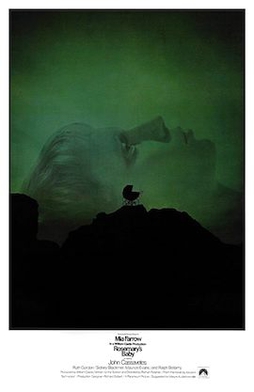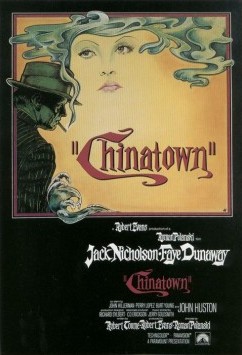Carol: Catherine Deneuve
Michael: Ian Hendry
Colin: John Fraser
Helen: Yvonne Furneaux
Landlord: Patrick Wymark
Miss Balch: Renee Houston
Madame Denise: Valerie Taylor
John: James Villiers
Bridget: Helen Fraser
Reggie: Hugh Futcher
Director: Roman Polanski
Screenplay: Roman Polanski, Gérard Brach
Cinematography: Gilbert Taylor
Art direction: Seamus Flannery
Film editing: Alastair McIntyre
Music: Chico Hamilton
Repulsion was only Roman Polanski's second feature film, yet it's the work of a master. It's nothing more than a portrait of a schizophrenic, played by the astonishingly beautiful Catherine Deneuve, and treated with a remarkable detachment. We don't know why Carol Ledoux is mad. A lesser director would have given us flashbacks to Carol's childhood and a depiction of some trauma that has driven her repulsion toward sex. But all we see of her childhood is a photograph of a family group, glimpsed three times in the film: Once when the camera is surveying the furnishings of the living room in the apartment she shares with her sister, Helen; again when the brutish landlord, before attempting to rape Carol, picks it up and identifies the little blond girl in the picture as her as a child; and at the very end, when the camera tracks into the photograph, singling out the girl and drawing ever closer to her face, finally closing in on the little girl's eye and bringing us back to the opening of the film and its closeup on the adult Carol's eye. The expression on her face is distant, almost blank -- an expression we have seen throughout the film on the grownup Carol's face. What are we to make of this? That Carol was the victim of a childhood sexual trauma? Polanski chooses not to tell us because the focus of his film is on the effect rather than the cause. Carol has apparently been "normal" enough to learn a trade as a beautician, to hold down a job in a salon, to have a handsome boyfriend. But suddenly that "normality" is shattered when her sister decides to go off on a vacation to Italy with her own boyfriend, Michael, whom Carol detests. Left to her own devices, Carol spirals into insanity and eventually into murder. Whenever a headline-making crime occurs -- a mass shooting or something like today's news about a Southern California couple who kept their children prisoners and starved and tortured them for years -- our first instinct is to ask why they did it. And we rarely come upon the sources of the criminal's disturbance. The neighbors usually say he was such a quiet boy, or she was shy and a little weird but seemed nice enough. Polanski keeps us on edge through the film by making Carol's environment one that is simultaneously ordinary and conducive to madness: a piano playing scales somewhere in the apartment building, a neighboring Catholic school ringing bells, a shabby apartment full of dark corners and odd angles, a beauty salon whose customers undergo grotesque treatments like mud packs to improve their looks. On the street she passes an odd trio of buskers (one of whom is played by Polanski) and is harassed by a construction worker. Even her boyfriend, Colin, is a little edgy, having dated this beautiful woman long enough to expect her to have sex with him. In the end, it's as if Carol lashes out at a world that gets on her nerves. Polanski's film seems to be asking if that horror resides within all of us.
A blog formerly known as Bookishness / By Charles Matthews
"Dazzled by so many and such marvelous inventions, the people of Macondo ... became indignant over the living images that the prosperous merchant Bruno Crespi projected in the theater with the lion-head ticket windows, for a character who had died and was buried in one film and for whose misfortune tears had been shed would reappear alive and transformed into an Arab in the next one. The audience, who had paid two cents apiece to share the difficulties of the actors, would not tolerate that outlandish fraud and they broke up the seats. The mayor, at the urging of Bruno Crespi, explained in a proclamation that the cinema was a machine of illusions that did not merit the emotional outbursts of the audience. With that discouraging explanation many ... decided not to return to the movies, considering that they already had too many troubles of their own to weep over the acted-out misfortunes of imaginary beings."--Gabriel García Márquez, One Hundred Years of Solitude
Search This Blog
Showing posts with label Roman Polanski. Show all posts
Showing posts with label Roman Polanski. Show all posts
Wednesday, January 17, 2018
Saturday, October 8, 2016
Rosemary's Baby (Roman Polanski, 1968)
I'm not boasting when I say that horror movies don't scare me. Sometimes I wish they did -- I'm missing out on the fun. It's just that since I learned to watch films analytically, studying performance and camerawork and storytelling, I usually see through the formulas of genre films. I know, for example, how to anticipate the surprises when you think that everything's okay and suddenly it isn't anymore -- e.g., the shocker moments in Wait Until Dark (Terence Young, 1967) or Carrie (Brian De Palma, 1976). The best I can hope for from a scary movie is to feel unsettled, which is what Rosemary's Baby does to me. I've seen it often enough to know where it's going, but when it arrives -- especially in the conception scene and in the final reveal -- I invariably suspend my analysis long enough to be drawn in. As director and screenwriter, Roman Polanski is a master, providing lovely, creepy bits like the figures that tiptoe across the background in the scene in which Rosemary (Mia Farrow) thinks she's alone in the apartment. But to my mind the film succeeds mostly because of Farrow's performance: She brings just the right amount of vulnerability to the role -- she doesn't even need the makeup-induced pallor to convince us that she is prey to something terrible. It always strikes me as odd that she has never earned an Oscar nomination. But all the performances in Rosemary's Baby are top-notch, starting with the one that did win an Oscar, Ruth Gordon's deliciously vulgar Minnie Castevet, who pronounces "pregnant" as if it had three syllables. John Cassavetes succeeds in the difficult role of Guy, Rosemary's husband; he has to be plausible as the sympathetic, loving spouse at the start -- giving in to Rosemary's desire for the fatal apartment -- but just abrasive enough with his wisecracks to suggest the cynicism and careerism that leads him to sell his soul to the devil-worshipers. Ralph Bellamy also has to be plausibly caring as Dr. Sapirstein to convince Rosemary and the audience that he's on the right side, while also preparing us for later revelations. Bellamy had a long and interesting career, from the schnook who gets the girl taken away from him by Cary Grant in The Awful Truth (Leo McCarey, 1937) and His Girl Friday (Howard Hawks, 1941), to the distinguished, gentlemanly, but sometimes sinister character in films like Trading Places (John Landis, 1983) and Pretty Woman (Garry Marshall, 1990). It's also good to see other veteran actors -- Sidney Blackmer, Elisha Cook Jr., and even that well-cured ham Maurice Evans -- doing fine ensemble work. Richard Sylbert's production design makes the most of the spooky gothic apartment house -- the exteriors are of the Dakota, but the interiors are sets. And Krzysztof Komeda, who had worked with Polanski in Poland, provides a score that's atmospheric without being overstated -- until it needs to be.
Thursday, February 4, 2016
Chinatown (Roman Polanski, 1974)
Where there's money, there's murder, and where the sun shines brightest, the shadows are darkest. That's why film noir was invented in Hollywood, and why California's greatest contribution to American literature may have been the pulp fiction of James M. Cain and the detective novels of Dashiell Hammett, Raymond Chandler, and Ross Macdonald. Chinatown, which draws on that tradition, has a kind of valedictory quality about it, harking back to the 1930s roots of noir, although the genre's heyday was the postwar 1940s and paranoia-filled early 1950s. (Curtis Hanson would exploit that latter era in his 1997 film L.A. Confidential.) But it's also very much a film of the 1970s, which is to say that 42 years have passed and Chinatown is showing its age. The revelation that Katherine (Belinda Palmer) is both the daughter and the sister to Evelyn Mulwray (Faye Dunaway) no longer has the power to shock that it once did, incestuous rape having become a standard trope of even TV drama. Nor does the "dark" ending, which director Roman Polanski insisted on, despite screenwriter Robert Towne's preference for a more conventionally hopeful resolution, seem so revolutionary anymore. It remains a great film, however, thanks to those quintessential '70s stars, Dunaway and Jack Nicholson, in career-defining performances, the superb villainy of John Huston's Noah Cross, and Roman Polanski's deft handling of Towne's intricate screenplay, carefully keeping the film limited to the point of view of Nicholson's Jake Gittes. Production designer Richard Sylbert and costume designer Anthea Sylbert (Richard's sister-in-law), aided by cinematographer John A. Alonzo, are responsible for the stylish evocation of 1930s Los Angeles. The atmospheric score is by Jerry Goldsmith.
Subscribe to:
Comments (Atom)


